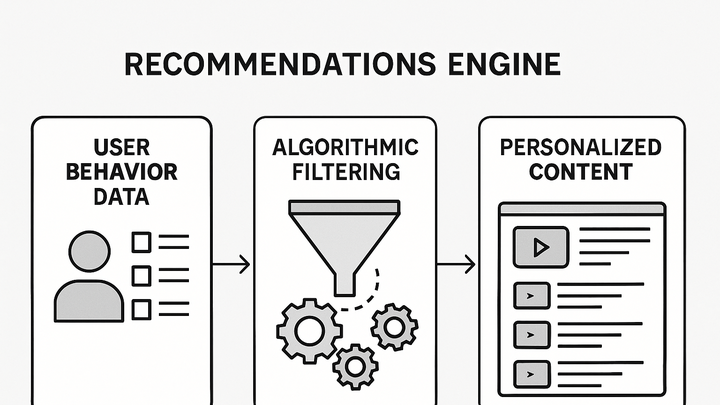Published on 2025-06-26T04:13:32Z
What is a Recommendations Engine? Analytics Examples & Use Cases
A recommendations engine is a software system that analyzes user behavior, preferences, and historical data to suggest relevant products, content, or actions in real time. In analytics, recommendation engines leverage data collected from user interactions—pageviews, clicks, conversions—to personalize user experiences and drive engagement. These systems can be built using collaborative filtering, content-based filtering, or hybrid approaches. SaaS analytics tools like Google Analytics 4 (GA4) and PlainSignal can feed event data into recommendation algorithms or measure the performance of recommended items. By integrating tracking snippets and custom events, businesses can fine-tune their recommendation strategies and optimize key metrics such as click-through rate and conversion rate.
Recommendations engine
System that uses user data to offer personalized product or content suggestions, boosting engagement and conversions.
Why Recommendations Engines Matter
Recommendation engines transform raw user data into actionable insights by delivering personalized suggestions. They enhance the customer journey by making content and product discovery more relevant and efficient.
-
Improved user engagement
By surfacing content and products that match user interests, recommendation engines increase time on site and reduce bounce rate.
-
Higher conversion rates
Tailored suggestions lead to more clicks and purchases, directly impacting revenue and ROI.
-
Personalized experience
Adapts to individual preferences, fostering customer loyalty and satisfaction.
Types of Recommendation Engines
Different recommendation algorithms serve varied business needs. Choosing the right type depends on available data, scale, and personalization goals.
-
Collaborative filtering
Recommends items based on patterns of user behavior, identifying similarities among users or items.
-
User-based filtering
Finds users with similar taste profiles and suggests items they liked.
-
Item-based filtering
Recommends items similar to those a user has interacted with previously.
-
-
Content-based filtering
Matches item attributes (e.g., keywords, categories) with user profiles to generate recommendations.
-
Keyword matching
Scores items based on shared keywords between item metadata and user preferences.
-
Feature similarity
Computes similarity using item features such as genre, brand, or tags.
-
-
Hybrid methods
Combines collaborative and content-based approaches to offset individual limitations and improve accuracy.
Implementation with Analytics SaaS Tools
SaaS analytics platforms can both supply data to recommendation algorithms and measure their effectiveness. Below are examples for PlainSignal and GA4.
-
PlainSignal integration
PlainSignal offers cookie-free event tracking to power and evaluate recommendation strategies. To implement, include the tracking snippet on pages displaying recommended items:
<link rel="preconnect" href="//eu.plainsignal.com/" crossorigin /> <script defer data-do="yourwebsitedomain.com" data-id="0GQV1xmtzQQ" data-api="//eu.plainsignal.com" src="//cdn.plainsignal.com/plainsignal-min.js"></script>Use PlainSignal events such as
recommendation_viewandrecommendation_clickto feed your engine or track performance.-
Track recommendation events
Capture click and view events for recommended items to feed algorithms or measure CTR.
-
Privacy-compliant data
Cookie-free tracking ensures compliance with GDPR and CCPA while collecting rich interaction data.
-
-
Google analytics 4 integration
GA4 supports custom events and predictive metrics that can enhance recommendation systems. Define events for recommendation impressions and clicks, then use predictive audiences or metrics to refine suggestions.
-
Define recommendation events
Set up custom events like
recommendation_viewandrecommendation_clickin GA4 with event parameters. -
Leverage predictive metrics
Use GA4’s predictions (e.g., purchase probability) to segment users for targeted recommendations.
-
Key Metrics to Monitor
Tracking the right metrics is crucial to assess and optimize recommendation performance.
-
Click-through rate (ctr)
Percentage of recommendation impressions that result in clicks.
-
Conversion rate
Percentage of recommendation clicks that lead to purchases or desired actions.
-
Average order value (aov)
Average revenue generated per transaction influenced by recommendations.
Best Practices and Considerations
When designing and deploying recommendation engines, consider the following guidelines to maximize impact and trust.
-
Data privacy and compliance
Ensure tracking methods and data usage adhere to privacy laws like GDPR and CCPA.
-
Algorithm transparency
Provide explanations or options for users to understand and control recommendations.
-
Continuous a/b testing
Regularly test different algorithms, UI placements, and content rules to discover what works best.
